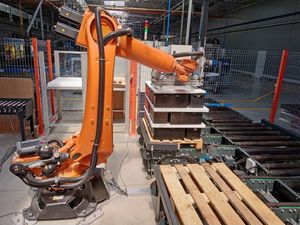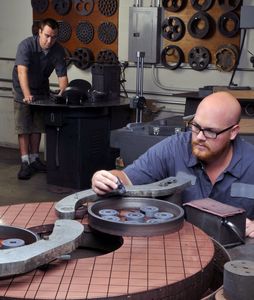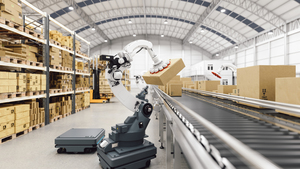
 |
Charlotte Stonestreet
Managing Editor |
| Home> | AUTOMATION | >Data Capture | >Automate these processes for a fast ROI |
| Home> | AUTOMATION | >Robots | >Automate these processes for a fast ROI |
| Home> | AUTOMATION | >Systems | >Automate these processes for a fast ROI |
Editor's Pick
Automate these processes for a fast ROI
29 July 2022
Looking to reap the benefits of automating manual processes in terms of cost reduction, quality improvement and increased safety? Neil Ballinger identifies tasks that, once automated, offer a particularly fast return on investment

SINCE THE emergence of the term Industry 4.0 in 2011, the digital journey of most manufacturers has been characterised by a marathon-like approach — slow and steady. For manufacturers who are not blessed with an endless stream of cash and expert teams of in-house technologists, the gradual implementation of automation has been the safest and most effective way of digitalising their premises.
However, the COVID-19 pandemic and its ripple effect on the global socio-political balance has forced manufacturers to digitalise at full throttle, effectively turning their Industry 4.0 journey from a marathon to a sprint. In this scenario, plant managers are under increasing pressure to make the best decision when prioritising processes to be switched from manual to digital.
Although the needs of every production or assembly plant differ, when planning an automation project there are three key variables that plant managers should consider — the speed of the return on investment (ROI), the ease of implementation, and the impact of the project on the workforce. Let’s see a few examples of digitalisation projects that win on all three fronts.
Pick & place
The repetitive act of picking up a piece and placing it in the correct spot for further processing is enough to test the patience of even the most motivated employee. When parts are heavy, difficult to manipulate or in close proximity to hot surfaces and dangerous machinery, the task turns from tedious to hazardous.
Luckily, pick and place applications are some of the easiest and most cost-effective to digitalise. There is a wide variety of robotic arms on the market that require little upfront investment, can be programmed with no coding expertise, and drastically facilitate employees’ work.
For example, igus’ latest cobot, part of the igus Rebel family, costs less than EUR 5,000 and can be programmed remotely through an online integration service that offers fixed-price consultations. This plug and play cobot is up and running in just a couple of days and can lift up to 2kg.
For heavier lifting, such as in palletising applications, prices are considerably higher — a standard solution handling one layer per minute starts at around EUR140,000, excluding integration and extra accessories. Programming and maintenance can also be quite complex and generally requires the assistance of a systems integrator.
However, automatic palletisers can have a huge impact on staff wellbeing, since manual palletisation is a demanding physical task that can often lead to accidents and repetitive strain injuries (RSIs). Though capital recovery might be slower than in other automation projects, the benefits in increased safety and staff retention will be worth the investment in the long run.
Quality assurance
The strict standards of Industry 4.0 make quality assurance (QA) an essential step of the manufacturing process. However, the cost and complexity of traditional machine vision solutions mean that many factories still rely on manual inspection.
Unfortunately, human inspectors cannot reliably check complex products for eight hours a day without missing defects. Think of a printed circuit board (PCB) — a single item can contain dozens of hardly visible sub-components, each of which can present defects that compromise the functionality of the whole board.
Luckily, new solutions that transcend the limitations of traditional machine vision are reaching the market. For example, German-Israeli company Inspekto has developed a cost-effective Autonomous Machine Vision system, the INSPEKTO S70, that can be set up by the plant’s own personnel, without the help of a machine vision expert. The system comes pre-trained for a wide variety of use cases, which drastically reduces installation time.
Machine vision solutions such as Inspekto’s lead to a quick ROI thanks to their ability to reduce the cost of defects, which can include material waste, re-working costs, late delivery fees, reputational damage and more.
Moreover, automating quality assurance can free up personnel to perform more engaging tasks that add value. The wide variety of machine vision companies on the market and the many low-code and no-code solutions they provide ensure that manufacturers can find a QA system that matches their budget and technical skills.
Data entry
Fast and reliable data entry is essential for all processes that require accurate, up-to-date information, from monitoring sensor data for predictive maintenance, to processing bills of materials.
Manual data entry can often become a bottleneck for businesses, as data entry clerks might not be able to keep up with the need for real-time information and might introduce errors while reporting figures. This is where automated data entry systems can help.
Using optical character recognition, data entry software can read information from a wide variety of sources, such as PDFs, e-mails and websites, and absorb it into a centralised data storage application, be it a database or simple spreadsheet.
Automated data entry has a wide range of applications. The most common and well-known is automated invoice scanning, but data entry software can help in countless scenarios, such as preparing reports for audits and quality controls, managing business enquiries, processing the results of customer satisfaction surveys and more.
On top of these benefits, data entry software is generally simple to install and manage and can be extremely cost-effective — Culverdocs, for example, offers an all-inclusive package for a monthly fee of only £20 per user.
Cashflow, employee retention and a technical skills gap are some of the biggest challenges manufacturers are currently facing. By considering the ROI of their automation projects, their impact on the workforce and how easily they can be deployed and maintained, manufacturers can speed up their digitalisation marathon, taking the leap they need to gain a considerable competitive advantage.
Neil Ballinger is head of EMEA at EU Automation
Key Points
- An automation project should consider the speed RoI, the ease of implementation, and impact of the project on the workforce
- Automating quality assurance can free up personnel to perform more engaging tasks that add value
- Automated data entry has a wide range of applications; software is generally simple to install and manage and can be extremely cost-effective
- OPC UA in the smart factory
- Remote working in engineering
- Scanning for safety
- Building a digital twin
- End-to-end intelligent automation
- Are you too small for industrial robotics?
- From science fiction to reality
- Gripper tech: challenges & opportunities
- Pets versus cattle: cloud computing in manufacturing
- How small manufacturers can implement digital technologies






















